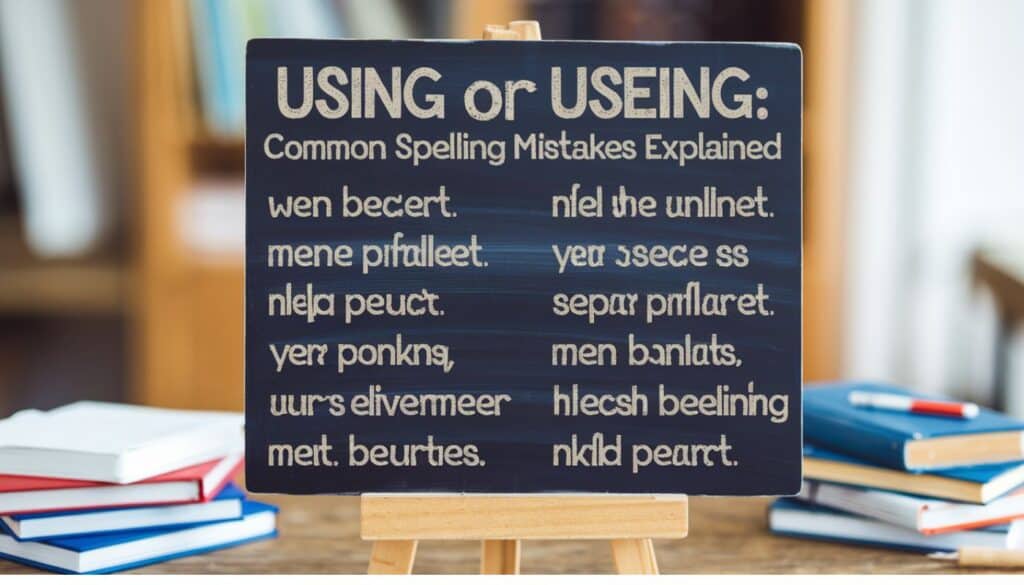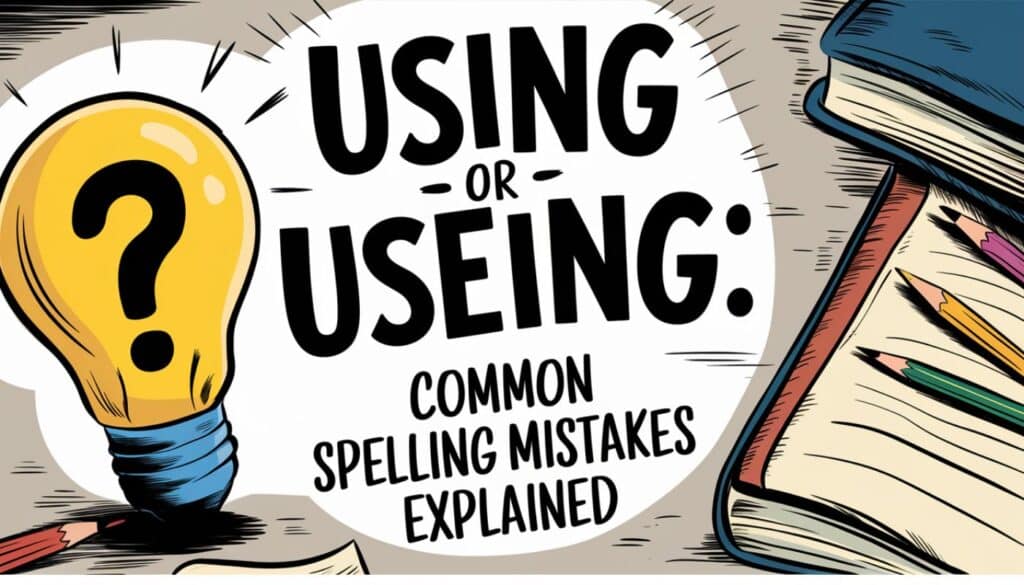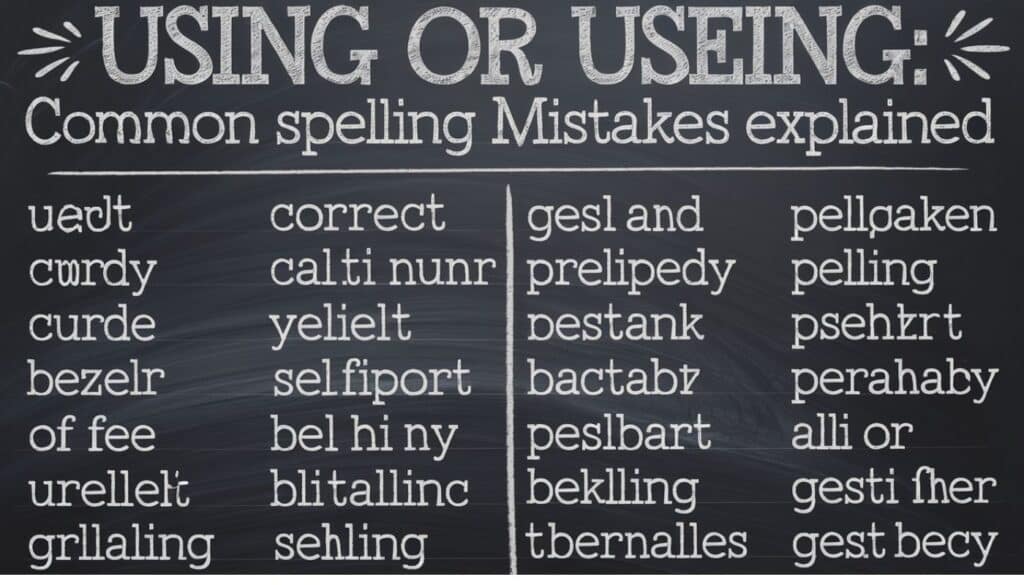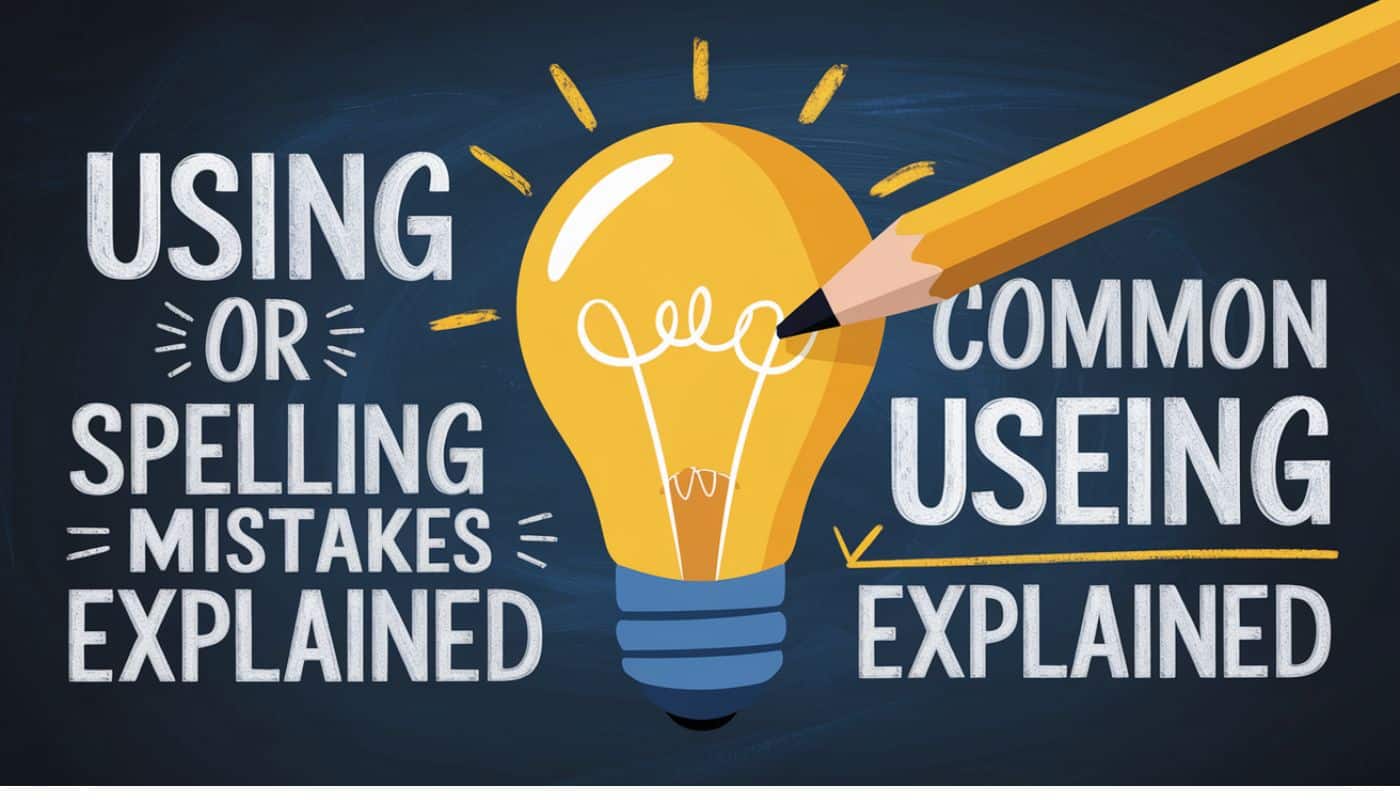Spelling mistakes are the uninvited guests of writing—they show up when you least expect them, often leaving a trail of confusion in their wake. One such common error is the confusion between using and useing.
While these words sound almost identical, only one is correct. Understanding the difference isn’t just about avoiding embarrassment; it’s about mastering the nuances of English to communicate clearly and effectively. Whether you’re a student, a professional, or a language enthusiast, this guide will help you navigate this common pitfall with confidence.
Quick Summary
Let’s cut to the chase:
- Correct Spelling: Using
- Incorrect Spelling: Useing
- Meaning: Using is the present participle of the verb use, meaning to employ something for a purpose.
- Key Takeaway: Drop the “e” when adding “-ing” to verbs that end with “e,” but remember that use is an exception to this rule.
Why the Confusion?

The confusion between using and useing stems from a few linguistic quirks:
- Phonetic Misleading: English pronunciation often doesn’t align with spelling. The word use ends with a silent “e,” which might make people think it should be retained when adding “-ing.”
- Influence of Other Verbs: Some verbs, like make (making) or take (taking), drop the “e” when forming the present participle. This pattern can mislead writers into thinking use follows the same rule.
- Overgeneralization: Language learners and even native speakers sometimes overapply grammar rules, leading to errors like useing.
For example, someone might write, “I am useing my phone,” thinking they’re following the “drop the ‘e’” rule. However, use is an exception, and the correct form is using.
Detailed Explanation & Correct Usage
Let’s break it down:
What Is Using?
Using is the present participle of the verb use. It describes an ongoing action where something is being employed for a purpose.
Examples:
- “She is using her laptop to finish the report.”
- “They are using the new software to streamline their workflow.”
In both cases, using indicates an action in progress.
Why Useing Is Incorrect
Useing is a misspelling that arises from misunderstanding English grammar rules. While many verbs drop the final “e” when adding “-ing” (e.g., make → making), use retains its “e” to form using.
Incorrect Example:
- “I am useing my time wisely.” (This should be using.)
The “Drop the ‘e’” Rule
In English, when a verb ends with a silent “e,” you typically drop the “e” before adding “-ing.” For example:
- Make → Making
- Take → Taking
- Write → Writing
However, use is an exception. The correct form is using, not useing.
Common Mistakes & How to Avoid Them
Here are some frequent errors and tips to steer clear of them:
Mistake 1: Adding an Extra “e”
Incorrect: “He is useing the tool to fix the issue.”
Correct: “He is using the tool to fix the issue.”
Tip: Remember that use is an exception to the “drop the ‘e’” rule.
Mistake 2: Confusing Use with Other Verbs
Incorrect: “She is useing her skills to solve the problem.”
Correct: “She is using her skills to solve the problem.”
Tip: Practice differentiating use from verbs like make or take, which do drop the “e.”
Mistake 3: Overreliance on Phonetics
Incorrect: “I am useing my phone to call you.”
Correct: “I am using my phone to call you.”
Tip: Don’t let pronunciation guide your spelling. English is full of exceptions, and using is one of them.
Synonyms or Alternatives

While using is the most common term, there are alternatives that can add variety to your writing:
- Employing: Suggests a formal or strategic use.
- Example: “The company is employing new technology to improve efficiency.”
- Utilizing: Implies making the most of something.
- Example: “She is utilizing her resources wisely.”
- Applying: Often used in contexts where something is put into practice.
- Example: “He is applying his knowledge to solve the problem.”
- Leveraging: Indicates using something to gain an advantage.
- Example: “They are leveraging social media to grow their business.”
Examples in Sentences

Here’s how using fits into various contexts:
Formal Contexts:
- “The scientist is using advanced equipment to conduct the experiment.”
- “By using data analytics, the team identified key trends.”
Informal Contexts:
- “I’m using my phone to check the weather.”
- “Are you using this chair, or can I take it?”
Creative Writing:
- “Using her imagination, she painted a world full of color and life.”
- “He was using every ounce of strength to climb the mountain.”
Origins & History
The word use has its roots in Latin, deriving from the word uti, meaning “to employ” or “to enjoy.” Over time, it evolved into Old French (user) and Middle English (usen), eventually becoming the modern English use.
Interestingly, the spelling of use has remained relatively consistent, but its participle form, using, has always retained the “e.” This historical consistency reinforces the importance of spelling it correctly.
Conclusion & Final Thoughts
Mastering the difference between using and useing is a small but significant step toward polished communication. By understanding the rules and exceptions, you can avoid common mistakes and write with confidence.
Remember:
- Using is the correct form.
- Useing is always incorrect.
- Practice, proofread, and use tools like spell check to catch errors.
Whether you’re drafting an email, writing an essay, or texting a friend, clear and correct spelling enhances your credibility and ensures your message is understood. So, the next time you’re tempted to write useing, take a moment to correct it to using. Your readers—and your future self—will thank you.

Emily Hudson, the creative mind behind “English Summa,” is a passionate English language educator with a Bachelor’s Degree in English and a Teaching Certification. Dedicated to making the intricacies of English accessible to learners, Emily brings a blend of expertise and enthusiasm to her readers. Follow English Summa for insightful language tips, literary explorations, and a shared love for the beauty of English.






![# **25 Ways to Say “Have a Good Evening” Professionally** In professional communication, the way you bid farewell can leave a lasting impression. While “Have a good evening” is a polite and common phrase, it can sometimes feel generic or lack the personal touch needed to strengthen relationships. Whether you’re speaking to colleagues, clients, or business partners, tailoring your farewell to the context can demonstrate thoughtfulness, cultural awareness, and professionalism. This article explores **25 professional ways to say “Have a Good Evening”**, complete with real-world scenarios, cultural considerations, and tips to elevate your communication. By the end, you’ll have a toolkit of phrases to suit any professional setting, ensuring your farewells are memorable and meaningful. --- ## **Why Your Farewell Matters** The way you end a conversation or email is more than just a formality—it’s an opportunity to reinforce relationships, express gratitude, and set the tone for future interactions. A well-crafted farewell can: - **Show appreciation**: Acknowledge the time and effort of the person you’re speaking to. - **Reflect professionalism**: Demonstrate your attention to detail and cultural sensitivity. - **Encourage positivity**: Leave the other person feeling valued and respected. In professional settings, the right phrase can enhance your reputation and foster stronger connections. Let’s dive into 25 alternatives to “Have a Good Evening,” each tailored to different contexts. --- ## **25 Professional Ways to Say “Have a Good Evening”** ### **1. Wishing You a Productive Evening** **Scenario**: Email to a Team *“Hi Team, thank you for your hard work today. Wishing you a productive evening as you wrap up your tasks. Let’s regroup tomorrow with fresh energy!”* **Why It Works**: This phrase motivates your team to stay focused while acknowledging their efforts. --- ### **2. Have a Restful Evening** **Scenario**: Closing a Meeting *“Thank you all for your contributions today. Have a restful evening—you’ve earned it!”* **Why It Works**: It emphasizes the importance of recharging, which is especially meaningful after a long day. --- ### **3. Enjoy a Relaxing Evening** **Scenario**: Follow-Up Email to a Client *“Dear [Client’s Name], thank you for your time today. I hope you enjoy a relaxing evening. Looking forward to our next steps!”* **Why It Works**: It conveys warmth and shows you care about their well-being. --- ### **4. Wishing You a Serene Evening** **Scenario**: Email to a Senior Colleague *“Thank you for your guidance today. Wishing you a serene evening ahead.”* **Why It Works**: The word “serene” adds a touch of elegance and calmness, perfect for formal settings. --- ### **5. Here’s to a Gentle Farewell** **Scenario**: Networking Event *“It was a pleasure connecting with you tonight. Here’s to a gentle farewell—until next time!”* **Why It Works**: This phrase is warm and memorable, ideal for informal professional settings. --- ### **6. Wishing You Evening Wishes** **Scenario**: Formal Email Sign-Off *“Thank you for your time today. Wishing you evening wishes as you unwind.”* **Why It Works**: It’s unique and adds a personal touch to your communication. --- ### **7. Enjoy a Well-Deserved Break** **Scenario**: Team Chat After a Busy Week *“Great job this week, everyone! Enjoy a well-deserved break this evening.”* **Why It Works**: It acknowledges hard work and fosters team morale. --- ### **8. Take Care This Evening** **Scenario**: Email to a Colleague *“Thanks for your help today. Take care this evening, and I’ll see you tomorrow!”* **Why It Works**: It’s simple, friendly, and shows genuine concern. --- ### **9. I Hope You Have a Thoughtful Closing** **Scenario**: End-of-Day Recap *“As we wrap up, I hope you have a thoughtful closing to your day. Reflect on your achievements—you’ve done great work!”* **Why It Works**: It encourages mindfulness and self-appreciation. --- ### **10. May Your Evening Be Productive** **Scenario**: Informal Chat with a Colleague *“Before you head out, may your evening be productive! Let’s keep the momentum going.”* **Why It Works**: It’s motivating and keeps the focus on progress. --- ### **11. Here’s to a Positive End to the Day** **Scenario**: Team Meeting Conclusion *“Let’s toast to a positive end to the day! Thank you for your hard work, everyone.”* **Why It Works**: It fosters camaraderie and leaves a lasting impression. --- ### **12. Wishing You a Peaceful Evening** **Scenario**: Email to a Client *“Thank you for your time today. Wishing you a peaceful evening as you review the details.”* **Why It Works**: It’s respectful and creates a calming tone. --- ### **13. May You Enjoy Your Evening** **Scenario**: Closing a Conference Call *“Thank you for your valuable input today. May you enjoy your evening, and let’s touch base again soon!”* **Why It Works**: It leaves a warm impression, encouraging ongoing collaboration. --- ### **14. I Hope You Can Unwind** **Scenario**: Email to a Co-worker *“Thanks for your efforts on the project. I hope you can unwind this evening; you’ve certainly earned it!”* **Why It Works**: It shows empathy and understanding of the need for downtime. --- ### **15. Have a Calm Evening Ahead** **Scenario**: Follow-Up After a Presentation *“Great job today, team! Have a calm evening ahead, and let’s regroup tomorrow to discuss next steps.”* **Why It Works**: It promotes tranquility and sets a positive tone for the following day. --- ### **16. Here’s to a Fulfilling Evening** **Scenario**: Team Building Event *“Thank you for your participation! Here’s to a fulfilling evening with your loved ones. Remember, balance is key!”* **Why It Works**: It reinforces the idea of work-life balance, encouraging employees to value their personal time. --- ### **17. Wishing You Relaxation and Joy** **Scenario**: Informal Email *“Hey Jamie, I wanted to say thanks for your support on the project. Wishing you relaxation and joy this evening! You deserve it.”* **Why It Works**: This friendly approach fosters a positive rapport and acknowledges hard work. --- ### **18. May Your Evening Be Bright** **Scenario**: Casual Goodbyes *“Take care, everyone! May your evening be bright and filled with fun! See you all tomorrow.”* **Why It Works**: It adds a cheerful touch, enhancing workplace relationships. --- ### **19. Hoping You Enjoy a Pleasant Evening** **Scenario**: Formal Email *“Dear Ms. Harris, thank you for your continued support. I hope you enjoy a pleasant evening after a busy day.”* **Why It Works**: It maintains a formal yet warm tone, suitable for professional interactions. --- ### **20. Have a Wonderful Evening Ahead** **Scenario**: Conclusion of a Workshop *“Thank you all for your engagement today. Have a wonderful evening ahead; I look forward to seeing you at our next session!”* **Why It Works**: It encourages ongoing learning and connection. --- ### **21. Here’s to Kind Farewells** **Scenario**: Ending a Client Meeting *“Thank you for your time today. Here’s to kind farewells and a successful partnership moving forward!”* **Why It Works**: It emphasizes mutual respect and the importance of positive relationships in business. --- ### **22. Wishing You a Refreshing Evening** **Scenario**: Email to a Mentor *“Thank you for your advice today. Wishing you a refreshing evening—you’ve inspired me to approach things differently!”* **Why It Works**: It shows gratitude and acknowledges their impact. --- ### **23. May Your Evening Be as Rewarding as Your Day** **Scenario**: Email to a Hardworking Colleague *“Your dedication today was impressive. May your evening be as rewarding as your day!”* **Why It Works**: It’s a creative way to compliment their efforts. --- ### **24. Here’s to a Smooth Transition into Evening** **Scenario**: End of a Busy Workday *“Great work today, everyone. Here’s to a smooth transition into evening—see you tomorrow!”* **Why It Works**: It acknowledges the shift from work to personal time. --- ### **25. Wishing You a Joyful Evening** **Scenario**: Casual Team Chat *“Thanks for the laughs today, team. Wishing you a joyful evening—see you tomorrow!”* **Why It Works**: It’s lighthearted and fosters a positive team culture. --- ## **Cultural and Professional Considerations** When choosing how to say “Have a Good Evening,” consider the following: 1. **Cultural Sensitivity**: In some cultures, overly personal phrases may be seen as intrusive. Stick to neutral, respectful language in formal or cross-cultural settings. 2. **Hierarchy**: When addressing senior colleagues or clients, opt for more formal phrases like “Wishing you a serene evening” or “May your evening be productive.” 3. **Context**: Tailor your farewell to the situation. For example, after a stressful meeting, phrases like “Have a restful evening” or “I hope you can unwind” show empathy. --- ## **Conclusion** The way you say “Have a Good Evening” can significantly impact your professional relationships. By choosing the right phrase for the context, you can leave a positive, lasting impression that reflects your thoughtfulness and professionalism. Whether you’re addressing a team, a client, or a colleague, these 25 alternatives will help you elevate your communication and foster stronger connections. Next time you bid farewell, try one of these phrases and observe how it shapes the tone of your interactions. Remember, a thoughtful goodbye is more than just words—it’s an opportunity to show appreciation, build rapport, and leave a lasting impact.](https://englishsumma.net/wp-content/uploads/2025/02/25-Ways-to-Say-Have-a-Good-Evening-Professionally-In-professional-communication-the-way-you-bid-farewell-can-leave-a-lasting-impression.-While-Have-a-good-evening--150x150.jpg)







